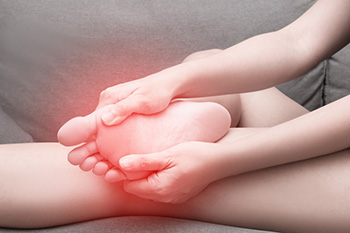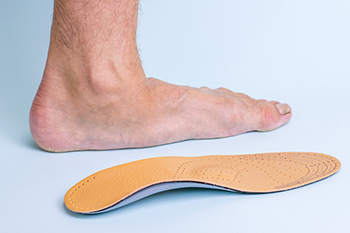Items filtered by date: April 2022
How to Tell if You’ve Fractured a Metatarsal Bone

The metatarsals are long bones in the foot that link the toes with the heel and arch. When these metatarsal bones are repeatedly stressed over time (as opposed to a sudden or acute injury), a stress fracture can occur. The second and third metatarsals are the most commonly injured, and can occur more frequently in military recruits, athletes and dancers who run and jump regularly. Metatarsal stress fractures can be caused by overtraining, long-distance running, having poor body mechanics or running form, pushing your body beyond your fitness level, or training with improper footwear or on hard surfaces. Having diabetes or certain forms of arthritis can also increase your risk factors, as can vitamin D or calcium deficiencies. Signs of a metatarsal fracture include pain in the metatarsal(s), as well as tenderness, or swelling in the area. If you have symptoms like these, it is suggested that you stop participating in physical activity until you can be examined and evaluated by a podiatrist. If you do have a metatarsal fracture, your podiatrist may treat it with rest, stretching and/or muscle strengthening exercises, icing, immobilization, casting, prescription footwear, and more.
Stress fractures occur when there is a tiny crack within a bone. To learn more, contact one of our podiatrists from Centers for Foot & Ankle Care. Our doctors can provide the care you need to keep you pain free and on your feet.
How Are They Caused?
Stress fractures are the result of repetitive force being placed on the bone. Since the lower leg and feet often carry most of the body’s weight, stress fractures are likely to occur in these areas. If you rush into a new exercise, you are more likely to develop a stress fracture since you are starting too much, too soon. Pain resulting from stress fractures may go unnoticed at first, however it may start to worsen over time.
Risk Factors
- Gender – They are more commonly found in women compared to men.
- Foot Problems – People with unusual arches in their feet are more likely to develop stress fractures.
- Certain Sports – Dancers, gymnasts, tennis players, runners, and basketball players are more likely to develop stress fractures.
- Lack of Nutrients – A lack of vitamin D and calcium may weaken the bones and make you more prone to stress fractures
- Weak Bones – Osteoporosis can weaken the bones therefore resulting in stress fractures
Stress fractures do not always heal properly, so it is important that you seek help from a podiatrist if you suspect you may have one. Ignoring your stress fracture may cause it to worsen, and you may develop chronic pain as well as additional fractures.
If you have any questions, please feel free to contact one of our offices located in Merrillville, Portage, Michigan City/LaPorte, and Schererville, IN . We offer the newest diagnostic and treatment technologies for all your foot care needs.
Can Obesity Cause Flat Feet?

The feet, and the arch, bear the body’s weight, and provide support and shock absorption. The arch is composed of several different structures, with the ligaments providing the lion’s share of stability and support. Excessive forces placed on the feet due to obesity can change the foot’s structure, negatively affecting the ligaments of the arch, and even causing flat feet in many overweight people. Studies even suggest that the degree of an overweight person’s flat footedness is directly correlated to their level of obesity, with a higher Body Mass Index (BMI) correlated with a lower plantar arch height. People with flat feet might experience complications such as plantar fasciitis, muscle cramping, arthritis, Achilles Tendonitis, and other forms of foot discomfort or pain. A podiatrist can help anyone, regardless of weight, who is experiencing discomfort from flat feet with custom orthotic devices, supportive shoes, stretching exercises and stretches, physical therapy, pain management medication and more.
Flatfoot is a condition many people suffer from. If you have flat feet, contact one of our podiatrists from Centers for Foot & Ankle Care. Our doctors will treat your foot and ankle needs.
What Are Flat Feet?
Flatfoot is a condition in which the arch of the foot is depressed and the sole of the foot is almost completely in contact with the ground. About 20-30% of the population generally has flat feet because their arches never formed during growth.
Conditions & Problems:
Having flat feet makes it difficult to run or walk because of the stress placed on the ankles.
Alignment – The general alignment of your legs can be disrupted, because the ankles move inward which can cause major discomfort.
Knees – If you have complications with your knees, flat feet can be a contributor to arthritis in that area.
Symptoms
- Pain around the heel or arch area
- Trouble standing on the tip toe
- Swelling around the inside of the ankle
- Flat look to one or both feet
- Having your shoes feel uneven when worn
Treatment
If you are experiencing pain and stress on the foot you may weaken the posterior tibial tendon, which runs around the inside of the ankle.
If you have any questions please feel free to contact one of our offices located in Merrillville, Portage, Michigan City/LaPorte, and Schererville, IN . We offer the newest diagnostic and treatment technologies for all your foot and ankle needs.
It's Time for Beautiful Feet
How Does Walking Improve My Health?
 Health experts find that getting on your feet and walking several times a week can make you feel better and help you stay better. Taking a walk is easy on the joints and doesn't pose much of a risk, although some people may wish to use walking sticks if balance is a concern. Walking is a good activity for all ages, so families can walk together. Best of all, walking is free, it can be done almost anywhere, and can be done any time of the day. The most important piece of equipment needed for walking is a good pair of walking shoes. These should fit your foot, have a roomy toe box, and have ample cushioning to reduce stress on the heels. Regular walking can reduce the risk of obesity, heart disease and strokes. It can help improve heart rate and circulation, muscle strength and bone strength. If you need more information on the best way to introduce walking as a regular exercise or help in finding the appropriate footwear, please don’t hesitate to speak to a podiatrist for guidance.
Health experts find that getting on your feet and walking several times a week can make you feel better and help you stay better. Taking a walk is easy on the joints and doesn't pose much of a risk, although some people may wish to use walking sticks if balance is a concern. Walking is a good activity for all ages, so families can walk together. Best of all, walking is free, it can be done almost anywhere, and can be done any time of the day. The most important piece of equipment needed for walking is a good pair of walking shoes. These should fit your foot, have a roomy toe box, and have ample cushioning to reduce stress on the heels. Regular walking can reduce the risk of obesity, heart disease and strokes. It can help improve heart rate and circulation, muscle strength and bone strength. If you need more information on the best way to introduce walking as a regular exercise or help in finding the appropriate footwear, please don’t hesitate to speak to a podiatrist for guidance.
Exercising your feet regularly with the proper foot wear is a great way to prevent injuries and build strength. If you have any concerns about your feet, contact one of our podiatrists from Centers for Foot & Ankle Care. Our doctors can provide the care you need to keep you pain-free and on your feet.
Exercise for Your Feet
Exercise for your feet can help you gain strength, mobility and flexibility in your feet. They say that strengthening your feet can be just as rewarding as strengthening another part of the body. Your feet are very important, and we often forget about them in our daily tasks. But it is because of our feet that are we able to get going and do what we need to. For those of us fortunate enough to not have any foot problems, it is an important gesture to take care of them to ensure good health in the long run.
Some foot health exercises can include ankle pumps, tip-toeing, toe rises, lifting off the floor doing reps and sets, and flexing the toes. It is best to speak with Our doctors to determine an appropriate regimen for your needs. Everyone’s needs and bodies are different, and the activities required to maintain strength in the feet vary from individual to individual.
Once you get into a routine of doing regular exercise, you may notice a difference in your feet and how strong they may become.
If you have any questions please feel free to contact one of our offices located in Merrillville, Portage, Michigan City/LaPorte, and Schererville, IN . We offer the newest diagnostic and treatment technologies for all your foot and ankle needs.
Blisters Will Gradually Drain
 A small area on the skin that is filled with liquid and resembles a bubble is referred to as a blister. Its function is to protect the damaged skin while new skin grows, and will gradually drain when the body no longer needs it. A blister often develops as a result of excessive friction from wearing shoes that do not fit correctly. Additionally, blisters can form from certain medical conditions, including psoriasis, frostbite, and eczema. An allergic reaction to an insect bite may cause a blister, or one may develop from specific types of chemicals. The blister can be protected by placing a bandage over it, as daily activities are completed. If you frequently develop blisters on your feet, please consult with a podiatrist who can provide you with reasons why and suggest correct preventative techniques.
A small area on the skin that is filled with liquid and resembles a bubble is referred to as a blister. Its function is to protect the damaged skin while new skin grows, and will gradually drain when the body no longer needs it. A blister often develops as a result of excessive friction from wearing shoes that do not fit correctly. Additionally, blisters can form from certain medical conditions, including psoriasis, frostbite, and eczema. An allergic reaction to an insect bite may cause a blister, or one may develop from specific types of chemicals. The blister can be protected by placing a bandage over it, as daily activities are completed. If you frequently develop blisters on your feet, please consult with a podiatrist who can provide you with reasons why and suggest correct preventative techniques.
Blisters are prone to making everyday activities extremely uncomfortable. If your feet are hurting, contact one of our podiatrists of Centers for Foot & Ankle Care. Our doctors can provide the care you need to keep you pain-free and on your feet.
Foot Blisters
Foot blisters develop as a result of constantly wearing tight or ill-fitting footwear. This happens due to the constant rubbing from the shoe, which can often lead to pain.
What Are Foot Blisters?
A foot blister is a small fluid-filled pocket that forms on the upper-most layer of the skin. Blisters are filled with clear fluid and can lead to blood drainage or pus if the area becomes infected.
How Do Blisters Form?
Blisters on the feet are often the result of constant friction of skin and material, usually by shoe rubbing. Walking in sandals, boots, or shoes that don’t fit properly for long periods of time can result in a blister. Having consistent foot moisture and humidity can easily lead to blister formation.
Prevention & Treatment
It is important to properly care for the affected area in order to prevent infection and ease the pain. Do not lance the blister and use a Band-Aid to provide pain relief. Also, be sure to keep your feet dry and wear proper fitting shoes. If you see blood or pus in a blister, seek assistance from a podiatrist.
If you have any questions, please feel free to contact one of our offices located in Merrillville, Portage, Michigan City/LaPorte, and Schererville, IN . We offer the newest diagnostic and treatment technologies for all your foot care needs.

